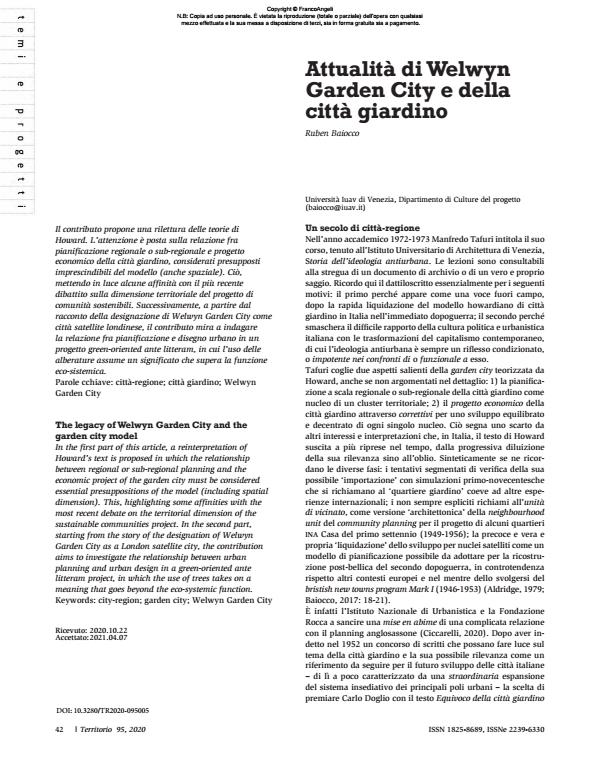The legacy of Welwyn Garden City and the garden city model
Journal title TERRITORIO
Author/s Ruben Baiocco
Publishing Year 2021 Issue 2020/95 Language Italian
Pages 11 P. 42-52 File size 1160 KB
DOI 10.3280/TR2020-095005
DOI is like a bar code for intellectual property: to have more infomation
click here
Below, you can see the article first page
If you want to buy this article in PDF format, you can do it, following the instructions to buy download credits

FrancoAngeli is member of Publishers International Linking Association, Inc (PILA), a not-for-profit association which run the CrossRef service enabling links to and from online scholarly content.
In the first part of this article, a reinterpretation of Howard’s text is proposed in which the relationship between regional or sub-regional planning and the economic project of the garden city must be considered essential presuppositions of the model (including spatial dimension). This, highlighting some affinities with the most recent debate on the territorial dimension of the sustainable communities project. In the second part, starting from the story of the designation of Welwyn Garden City as a London satellite city, the contribution aims to investigate the relationship between urban planning and urban design in a green-oriented ante litteram project, in which the use of trees takes on a meaning that goes beyond the eco-systemic function.
Keywords: City-region; garden city; Welwyn Garden City
- Welwyn Garden City Foundation, 2019, The City of Trees. www.wgccityoftrees.org.uk/about-wgc-the-city-of-trees/ (accesso: giugno 2020).
- Aldridge M., 1979, The British New Towns. A Program Without a Policy. London: Routledge & Kegan Paul.
- Aldous T., 1992, Urban Villages. A Concept for Creating Mixed-use Urban Developments on a Sustainable Scale. London: Urban Villages Group Allen W., Beevers R., Hall D., Hebbert M., Miller M., Onslow J., 1989, The Garden City and New Towns. Five Lectures. Hertford: Hertfordshire Pubblications.
- Arrighi G., 1994, The Long Twentieth Century. London-New York: Verso Book.
- Baiocco R., 2009, «Persistenza della neighbourhood unit: il welfare come medium fra spazio fisico e spazio sociale». In: Palazzo A.L., Giecillo L.
- (a cura di), Territori dell’urbano. Storie e linguaggi dello spazio comune. Macerata: Quodlibet, 82-103.
- Baiocco R., 2017, L’ultima new town. Milton Keynes tra welfare e scelta individuale. Macerata: Quodlibet.
- Bauer C., 1934, Modern Housing. Boston-New York: Houghton Mifflin Company.
- Breheny M., Rockwood R., 1993, «Planning the sustainable city region».
- In: Blowers A. (ed.), Planning for a Sustainable Environment. London: Earthscan, 150-189.
- Brenner N., Schmid, 2011, «Planetary Urbanization». In: Gandy M. (ed.), Urban Constellation. Berlin: Jovis, 10-13.
- Buder S., 1990, Visionaries and Planners: The Garden City Movement and the Modern Community. Oxford University Press: New York.
- Burdett R., Sudjic D., 2011, eds., Living in the Endless City. The Urban Project. London: Phaidon Press Ltd.
- Calthorpe P., 1993, The Next American Metropolis: Ecology, Community and the American Dream. New York: Princeton Architectural Press.
- Calthorpe P., Fulton W., 2001, The Regional City. Planning for the End of Sprawl. Washington-Covedo-London: Island Press.
- Ciccarelli L., 2020, Il mito dell’equilibrio. Il dibattito anglo-italiano per del territorio negli anni del dopoguerra. Milano: FrancoAngeli.
- Crimson, 2002, Crimson Architectural Historians. Rotterdam: 010 Publishers. De Carlo G., 1998, «A Carrara senza i CC ». A. Rivista anarchica, 243: 35-38.
- De Carlo G., 2019, La città e il territorio. Quattro lezioni. Macerata: Quodlibet.
- Doglio C., 1953, L’equivoco della città giardino. Napoli: Edizioni RL.
- Gibberd F., 1953, Town Design. London: The Architectural Press.
- Gottmann J., 1961, Megalopolis. The Urbanised Noth Eastern Seabord of the US. New York: Twenty Century Fund.
- Hall P. Ward, C.,1998, Sociable Cities: The Legacy of Ebenezer Howard. Chichester: Wiley.
- Hardy D., 1991, From Garden Cities to New Towns. Campaigning for Town and Country Planning 1899-1946. London: E & FN Spoon.
- Howard E., 2003, To-morrow. A Peaceful Path for Real Reform. Original edition with commentary by Peter Hall, Dennis Hardy, Colin Ward. London: Routledge.
- Magin D., 2004, La ville franchisée. Formes et structures de la ville contemporaine. Paris: Les éditions de la Villette.
- Nail P., 2003, ed., Urban Villages and the Making of Community. London: Spoon Press.
- Olmo, C. 1992, Urbanistica e società civile. Torino: Bollati Boringhieri-Fondazione Olivetti.
- Osborn F.J., 1970, Genesis of Welwyn Garden City - Some Jubilee Memories. London: Town and Country Planning Association.
- Osborn F. J., 1963, Whittick A., New Towns. The Answer to Megalopolis. London: L. Hill.
- Panerai P. Castex J., Depaule, J.C. Samuels, I., 2004, Urban Forms. The Death and Life of the Urban Block. Oxford: Architectural Press.
- Purdom C. B., 1917, The Garden City After the War. A Discussion of the Position of the Garden City at Letchworth, and a Proposal for a National Housing Policy. Privately published pamphlet.
- Tafuri M., 1973, Storia dell’ideologia antiurbana. Venezia: Biblioteca dell’Università Iuav di Venezia.
- Tafuri M., Dal Co F., 1979, Architettura Contemporanea. Milano: Electa.
- Unwin R., 1971, La pratica della progettazione urbana. Milano: Il Saggiatore.
- Walker D., 1982, The Architecture and Planning of Milton Keynes. London: The Architectural Press.
Ruben Baiocco, Attualità di Welwyn Garden City e della città giardino in "TERRITORIO" 95/2020, pp 42-52, DOI: 10.3280/TR2020-095005